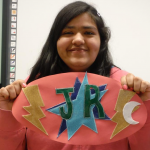Curriculum Example: Goudy Technology Academy 2018
We worked with Goudy Technology Academy during the 2016-2017 school year to integrate visual art and engineering. Below is a description of their project, as it was documented in their classroom portfolio.
 Project Title: Air, Land, Water, Sculpture
Project Title: Air, Land, Water, Sculpture- School: Goudy Elementary
- Teacher(s): Patty Whitehouse
- Artist(s): Margy Stover
- Grade(s): 2
- Academic focus: Engineering
- Artistic focus: Kinetic sculpture
The Big Idea: Integrating engineering with art to explore how sculpture can interact with forces, such as air, in the same ways that windmills and turbines do.
Inquiry Question: How can you create a sculpture based on the interaction forces and materials?
Project Narrative:
Patty is the Engineering Lab teacher for K-6 students at Goudy Technology Academy, focusing on the engineering part of Goudy Technology Academy’s science curriculum that is aligned with the Next Generation Science Standards (NGSS). Students in 2nd grade are working with wind forces as part of their weather unit. They create windmills that must fit a particular set of constraints and criteria as described earlier in this project. Once that project is completed, students use what they’ve learned about wind, windmills, materials and engineering design process to create mobile sculptures that move in the wind. Each class used a different theme for their mobiles. One class made mobiles that moved as if they were in water when they were blown around by the fan. A second class created mobiles that represented things that moved on land, and the third class created mobiles that represented things that moved in the air–and space.
Students used a basic form of the Engineering Design Process to support their plans. The process includes:
Asking Questions about the project to learn about the constraints and criteria for the project: — –What kinds of things move in the water/land/air?
-Which materials are available? How can I represent things I need with the materials available for use?
-What does the sculpture need to do? Which parts will move? How do the materials interact? How will I hold up my mobile?
Imagining a Solution to the engineering problem at hand. This is the brainstorming portion of the project. Students sketch their ideas in a journal, share them with their team, and make a decision about which ideas they want to work on.
Making a Plan from the imagined solutions. A plan shows the design, the type, size and quantity of materials needed.
Creating the Sculpture using the plan. This is place where students may find out that the plan needs refining because the sculpture does not work as planned.
Revising/Improving the Sculpture until the constraints and criteria are met to a satisfactory degree. This part of the process may take several iterations, and may send the students back to any prior portion of the process.

Project Outcomes:
- In the past, we worked with 3rd and 4th graders, who seemed to have a better connection between what they could do and what they wanted to do. Second graders are still working on that concept, and they had a more difficult time with their mobiles not looking like they originally wanted them to. What is always surprising is the creativity of students of any age when they are given the opportunity to make use of their imaginations. The end products were amazing!
- Students were their own critics and masters of their mobile design. In the end, they were able to create a series of mobiles that met the criteria and constraints with a great deal more imagination than we originally anticipated. Building and designing require less common language, so students with less command of English were able to flourish as designers and builders. Students and teachers in Kindergarten-3rd grade were given a “tour” of the mobile-scape. Other students, teachers, and visitors were able to see the sculptures for two weeks when it was set up in the hall. Sharing this project accomplished a couple of things: The three second grade classes were interested in seeing what the other classes were doing in relation to their theme. They all used the same materials but did so many different things with them! We were able to talk about interpreting and critique–in 2nd grade terms, of course–so they were able to enjoy and comment on others’ work without feeling like they had to compare it to their own. And now four other teachers to want to participate in CAPE next year!

Academic Standards Addressed:
Science and Engineering
2-PS1-2 Matter and Its Interactions
Analyze data obtained from testing different materials to determine which materials have the properties that are best suited for an intended purpose.*
ETS1.A: Defining and Delimiting Engineering Problems
A situation that people want to change or create can be approached as a problem to be solved through engineering. (K-2-ETS1-1)
Asking questions, making observations, and gathering information are helpful in thinking about problems. (K-2-ETS1-1)
Before beginning to design a solution, it is important to clearly understand the problem. (K-2-ETS1-1)
ETS1.B: Developing Possible Solutions
Designs can be conveyed through sketches, drawings, or physical models. These representations are useful in communicating ideas for a problem’s solutions to other people. (K-2-ETS1-2)
ETS1.C: Optimizing the Design Solution
Because there is always more than one possible solution to a problem, it is useful to compare and test designs. (K-2-ETS1-3)
1. Understanding and applying media, techniques, and processes
2. Using knowledge of structures and functions
3. Choosing and evaluating a range of subject matter, symbols, and ideas (students understand how their formal choices are connected to their concept and that their art represents bigger ideas)
5. Reflecting upon and assessing the characteristics and merits of their work and the work of others
6. Making connections between visual arts and other disciplines





